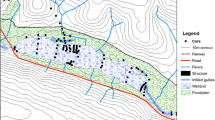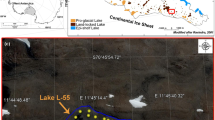Abstract
The magnetic parameters S.I.R.M. and magnetic susceptibility have been used to try and establish the fire histories of lake drainage basins. The technique is demonstrated using sediments from three lakes: Llyn Bychan (N. Wales), a lake with a recently burnt catchment, Lake Biscarrosse (S. W. France), a lake with a well documented fire history, and Lake Laukunlampi (E. Finland), a lake with laminated sediments and a long, but unknown fire history.
Similar content being viewed by others
References
Battarbee, R. W., in press. Diatom and chrysophyceae microstratigraphy of the annually laminated sediments of a small meromictic lake in N. Karelia, Finland. Striae.
Digerfeldt, G., Battarbee, R. W. & Bengtsson, L., 1975. Report on annually laminated sediment in Lake Jälarsjön, Nacka, Stockholm. Geol. För. Stockh. Förh. 97: 29–40.
Faegri, K. & Iversen, J., 1964. Textbook of Pollen Analysis. Blackwell scientific Publications, Oxford.
Huttunen, P. & Meriläinen, J., 1978. New freezing device providing large unmixed sediment samples from lakes. Ann. bot. fenn. 15: 128–130.
Le Borgne, E., 1955. Susceptibilité magnetique anormale du sol superficial. Ann. Geophys. 11: 399–419.
Longworth, G., Becker, L. W., Thompson, R., Oldfield, F., Dearing, J. A. & Rummery, T. A. 1979. Mössbauer effect and magnetic studies of secondary iron oxides in soils. J. Soil Sci. 30: 93–110.
Oldfield, F., 1978. Pollen analysis of recent sediments from two lakes near Halifax Nova Scotia, Canada. Pollen Spores 20: 167–175.
Oldfield, F., Dearing, J., Thompson, R. & Garret-Jones, S., 1978. Some magnetic properties of lake sediments and their possible links with erosion rates. Pol. Arch. Hydrobiol. 25: 321–331.
Oldfield, F., Thompson, R. & Dickson, D. P. E., 1981. Artificial magnetic enhancement of stream bedload: a hydrological application of supermagnetism. Phys. Earth planet. Interiors 26: 107–124.
Rummery, T. A., Bloemendal, J., Dearing, J., Oldfield, F. & Thompson, R. 1979. The persistence of fire-induced magnetic oxides in soils and lake sediments. Ann. Geophys. 35: 103–107.
Rummery, T. A., 1981. The Effects of Fire on Soil and Sediment Magnetism. Unpubl. Ph.D. Thesis. Univ. Liverpool.
Swain, A. M., 1973. A History of fire and vegetation in north-eastern Minnesota as recorded in lake sediments. Quat. Res. 3: 383–396.
Author information
Authors and Affiliations
Rights and permissions
About this article
Cite this article
Rummery, T.A. The use of magnetic measurements in interpreting the fire histories of lake drainage basins. Hydrobiologia 103, 53–58 (1983). https://doi.org/10.1007/BF00028427
Issue Date:
DOI: https://doi.org/10.1007/BF00028427




